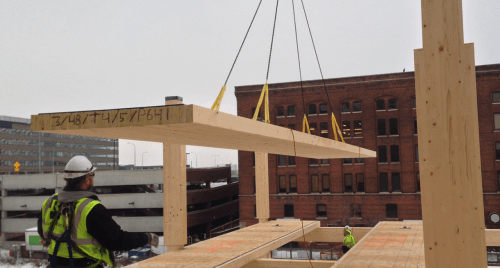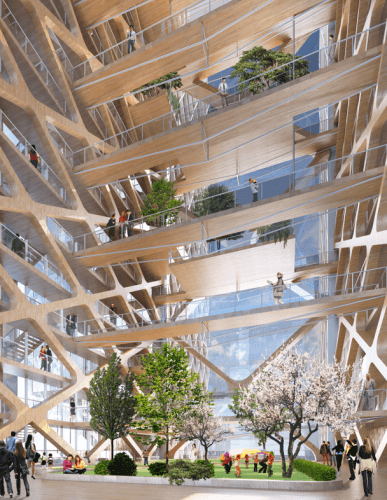
In recent years a small renaissance has taken place in North America regarding wood buildings, propelled by the emergence of “mass timber” construction. The increased popularity of mass timber is allowing wood buildings to stretch new heights beyond traditional wood-frame construction, ushering in an era of high-rise wood buildings. For example, the 18-story Brock Commons residential tower, completed in 2017, at the University of British Columbia in Vancouver is now the world’s tallest wood building (Hasan, 2017). In February of 2018, the Vancouver-based development firm PortLiving broke ground on the Terrace House, a 19-story mixed-use property to be completed in 2020 using mass timber (Ditmars, 2018).
In addition to mass timber projects sprouting up in Canada, several projects in the United States have also begun to take shape as well. Developed by Hines and completed in 2016, the 7-story T3 office building in Minneapolis became the first modern tall wood building in the U.S. Hines has further committed to mass timber construction, announcing in 2017 the T3 Goose Island in Chicago, a 6-story, 270,000 square foot building. In February of 2018, the company also announced plans for an 11-story, 500,000 square foot mass timber building in Newark, New Jersey (Gibson, 2018). In October of this year, Milwaukee based developer New Land Enterprises revealed plans for the Ascent, a 21-story 410,000 square foot mixed-use tower in Downtown Milwaukee. These are just a few examples of the many mass timber buildings that are in development around the world.
What is Mass Timber?
Different from traditional wood-frame construction, mass timber is a type of engineered wood where layers of wood planks are placed over each other to create a structure that has a load bearing capacity equal to some grades of steel. The layers of wood in mass timber may be combined in a few different ways to create these products. Dowel-laminated timber (DLT) is formed by stacking softwood lumber panels which are friction-fit together with hardwood dowels. Nail-laminated timber (NLT) is created by stacking lumber sheets and fastening them together with nails. Perhaps the most widely used mass timber product is cross-laminated timber (CLT), which is created by stacking lumber in alternating directions and bonding them together with structural adhesives.
What are the benefits of using mass timber?
 Several benefits to mass timber construction exist when compared to traditional steel frame and concrete construction. Perhaps the most the notable is the reduced time necessary to complete a mass timber building. In mass timber construction a substantial portion of the construction is done off-site in factories, then shipped to the project site and installed, saving time. Brock Commons was completed in 70 days (Hasan, 2017)and the T3 Minneapolis was completed in 9.5 weeks (Brownell, 2016). In addition to the time saved, wood is lighter than steel and concrete. Mass timber buildings are about one-fifth the weight of traditional buildings, leading to reduced foundation costs (Brownell, 2016).
Several benefits to mass timber construction exist when compared to traditional steel frame and concrete construction. Perhaps the most the notable is the reduced time necessary to complete a mass timber building. In mass timber construction a substantial portion of the construction is done off-site in factories, then shipped to the project site and installed, saving time. Brock Commons was completed in 70 days (Hasan, 2017)and the T3 Minneapolis was completed in 9.5 weeks (Brownell, 2016). In addition to the time saved, wood is lighter than steel and concrete. Mass timber buildings are about one-fifth the weight of traditional buildings, leading to reduced foundation costs (Brownell, 2016).
In addition to cost savings, mass timber also has the potential to provide intangible benefits. Constructing with wood is a way of bringing nature into the internal environment of buildings. The material becomes ingrained in the form and aesthetics of the building. Users are often highly attuned with nature, and studies have shown that increased exposure to trees and plants can reduce stress and anxiety (Rodriguez, 2015). Thus, wood buildings have the potential to provide more tranquil environments for end users.
 Could Mass Timber Be the Next Step in Sustainable Development?
Could Mass Timber Be the Next Step in Sustainable Development?
With an increase in the understanding of the environmental impact, buildings have on the planet, the need to develop more sustainable building practices is becoming more important. Mass timber takes green building another step forward. It has been reported that replacing steel frame and concrete construction with mass timber could cut CO2emissions by 15-20% (Cornwall, 2016). Wood is also a renewable material and its harvesting could impact climate change as an increase in forests could absorb more CO2from the atmosphere(Cornwall, 2016).
What is the Future of Mass Timber Buildings?
The most common misconception about mass timber buildings is their ability to hold up against fires. Wood is known as a highly combustible material and the idea of constructing tall buildings of wood may cause concern. Multiple-story fire tests at the U.S. Government’s ATF Fire Research Laboratory have been repeatedly conducted to test the structural integrity of mass timber to demonstrate fire safety (Douglas H. Evans).
The use of mass timber also faces challenges in the interpretation of building codes. In most places, wood buildings are restricted by height and many of the mass timber buildings that have been built or that are currently on the drawing boards must apply for special exemptions. This could soon change. In 2015, the International Code Council, the developer of U.S. building codes, created an ad hoc committee of subject matter experts to research and propose changes to the International Building Code (IBC) for the safe construction and use of mass timber buildings (Douglas H. Evans). In August of this year, Oregon amended its state building code to become the first state in the country to allow timber buildings to be constructed higher than six stories without any special considerations (Hilburg, 2018).
However, increasing demand for American lumber and recently implemented tariffs on Canadian products have jeopardized the financing of many mass timber projects. In July, Portland based developer Project^ shelved a project called the Framework building. Slated to include 60 affordable housing units and with $6 million in subsidies in hand, Project^ was unable to secure the needed financing due to these increased costs.
As these challenges are met, the interest in mass timber continues to grow. Although the current tallest building is 17-stories, many believe the form can be pushed much further. In 2015, in a design competition, Michael Green Architects, one of the world leaders in mass timber design, reimagined the Empire State Building constructed of mass timber. In 2016, in a joint project, PLP Architecture and Cambridge University’s Centre for Natural Material Innovation proposed the Oakwood Tower, an 80-story tower in the heart of London. Earlier this year, the Japanese company Sumitomo Forestry announced plans for a 1,148-feet-tall timber tower to be completed in 2041, to mark its 350th anniversary in that year. With advocates of mass timer pushing the boundaries of what is possible, it may one day be possible to see wooden buildings covering the skylines of many of the world’s cities.
References
Brownell, B. (2016, November 08). T3 Becomes the First Modern Tall Wood Building in the U.S.Retrieved from Architectmagazine.com: https://www.architectmagazine.com/technology/t3-becomes-the-first-modern-tall-wood-building-in-the-us_o
Cornwall, W. (2016, September 22). Would you live in a wooden skyscraper? Retrieved from Sciencemag: https://www.sciencemag.org/news/2016/09/would-you-live-wooden-skyscraper
Ditmars, H. (2018, February 19). Shigeru Ban’s timber-framed Terrace House breaks ground in Vancouver. Retrieved from Wallpaper.com: https://www.wallpaper.com/architecture/vancouver-shigeru-ban-terrace-house
Douglas H. Evans, S. K. (n.d.). A Fire Safety, Environmental, and Economic Assessment of Modifying Building Codes for Tall Mass Timber Buildings.Mass Timber Code Coalition.
Gibson, S. (2018, February 14). Mass Timber Tower Planned in Newark. Retrieved from Greeb Building Advisor: https://www.greenbuildingadvisor.com/article/mass-timber-tower-planned-in-newark
Hasan, Z. G. (2017, September 18). Inside Vancouver’s Brock Commons, the World’s Tallest Mass Timber Building. Retrieved from Archdaily.com: https://www.archdaily.com/879625/inside-vancouvers-brock-commons-the-worlds-tallest-timber-structured-building
Hilburg, J. (2018, August 14). Oregon becomes first state to legalize mass timber high rises. Retrieved from TheArhitectsNewspaper: https://archpaper.com/2018/08/oregon-legalize-mass-timber-high-rises/
Monahan, R. (2018, July 16). Plans for Record-Setting Timber Tower in Downtown Portland Fall Through.Retrieved from WillametteWeek: https://www.wweek.com/news/city/2018/07/16/plans-for-record-setting-timber-tower-in-downtown-portland-fall-through/
Rodriguez, T. (2015, October 20). The Mental Health Benefits of Nature Exposure.Retrieved from PsychiatryAdvisor: https://www.psychiatryadvisor.com/mood-disorders/nature-cognitive-anxiety-depression-mood/article/448018/
T3 Minneapolis Office Building. (n.d.). Retrieved from Structurecraft.com: https://structurecraft.com/projects/t3-minneapolis
